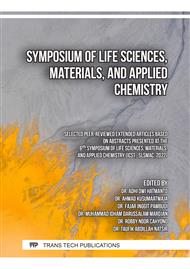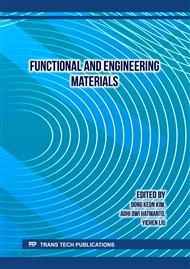[1]
A.B. Ginting and D. Anggraini, Metode Pengendapan dan Penukar Kation untuk Pemisahan Cesium dalam Bahan Bakar U3Si2-Al, Urania, Vol. 22 No. 2, p.65 – 132, 2016.
DOI: 10.17146/urania.2016.22.2.3092
Google Scholar
[2]
D. Anggraini, A. Nugroho, A.B. Ginting, Y. Nampira, and Boybul, Penentuan Parameter Optimum Proses Pengendapan CsClO4 pada Pemisahan Isotop 137Cs dari Larutan PEB U3Si2/Al Pasca Iradiasi, Urania. Vol. 19 No. 2, p.63 – 118, 2013.
DOI: 10.17146/urania.2017.23.2.3576
Google Scholar
[3]
Noviarty, E. Noerpitasari, R. Kriswarini, A. Jamaludin, S. Indaryati, S. Nisa, and S. Fatimah, Penentuan Recovery Neodymium dan Cerium pada Proses Pemisahan Isotop dari Simulasi PEB U3Si2/Al Pra Iradiasi, Urania, Vol. 26 No. 1, p.37 – 48, 2019.
DOI: 10.17146/urania.2020.26.1.5791
Google Scholar
[4]
C. Yuksel, The Use of Neodymium Magnets in Healthcare and Their Effects on Health, Istanbul Turkey, 2018.
DOI: 10.14744/nci.2017.00483
Google Scholar
[5]
M. Setyadji and Suyanti, Extraction of Neodymium (III) from Neodymium Concentrate Using Synergistic Solvent D2EHPA, TOPO and TBP, J. Phys. Conf. Ser., vol. 1198. no. 3, 2019.
DOI: 10.1088/1742-6596/1198/3/032001
Google Scholar
[6]
H. Handoyo, I.M. Bendiyasa, and A. Prasetya, Pelindian Neodymium dari Magnetik Coal Fly Ash menggunakan Asam Asetat sebagai Pelarut, Eksergi 16 (1), p.42 – 46, 2019.
DOI: 10.31315/e.v16i2.3027
Google Scholar
[7]
V. Prakash, Z.H.I. Sun, J. Sietsma, and Y. Yang, Electrochemical Recovery of Rare Earth Elements from Magnet Scraps ‐ a Theoretical Analysis, Eur. Rare Earth Resour. Conf., p.163 – 170, 2014.
DOI: 10.1016/b978-0-12-802328-0.00022-x
Google Scholar
[8]
A.B. Ginting, Boybul, A. Nugroho, Yanlinastuti, Noviarty, G. Wurdiyanto, and H. Chandra, Pembuatan Standar Cesium dari Larutan PEB U3Si2Al Pasca Iradiasi Densitas 2,96 gU/cm3 dengan Metode Pengendapan CsClO4, Urania, Vol. 25 No. 2, p.115 – 125, 2019.
DOI: 10.17146/urania.2019.25.2.5457
Google Scholar
[9]
A.B. Ginting, Boybul, D. Anggraini, A. Nugroho, R. Kriswarini, G. Wurdiyanto, and Hermawan, Pembuatan Isotop 137Cs Sebagai Sumber Radiasi Gamma untuk Digunakan dalam Industri, Urania, Vol. 20 No. 3, p.147 – 155, 2014.
DOI: 10.17146/urania.2015.21.3.2463
Google Scholar
[10]
J. S. Kim. Y. S. Jeon. S. D. Park. Y. K. Ha. and K. Song, Analysis of High Burnup Pressurized Water Reactor Fuel Using Uranium, Plutonium, Neodymium and Cesium Isotope Correlations with Burnup, Nucl. Eng. Technol. vol. 47. no. 7, p.924–933, 2015, doi: 10.1016/j.net. 2015.08.002.
DOI: 10.1016/j.net.2015.08.002
Google Scholar
[11]
K. S. Choi, J. S. Kim, S. H. Han, S. D. Park, Y. J. Park, K. S. Joe, and W. H. Kim, The Study on The Separation of Neodymium from The Simulated Solution of U3Si/Al Spent Nuclear Fuel, Analytical Science and Technology, vol. 13 no. 5, pp.584-591, 2000.
Google Scholar
[12]
M. Romadhan. N. E. Suyatma. and F. M. Taqi. Synthesis of ZnO nanoparticles by Precipitation Method With Their Antibacterial Effect, Indones. J. Chem., vol. 16. no. 2, p.117–123. 2016.
DOI: 10.22146/ijc.21153
Google Scholar
[13]
Z.N. Abdul-ameer. Novel Co-Precipitation Method for Synthesis of Nanostructured Nickel Oxide in Accordance to PH: Structural and Optical Properties as An Active Optical Filter, Ibn AL- Haitham J. Pure Appl. Sci., vol. 32 no. 1, pp.1-6, 2019.
DOI: 10.30526/32.1.1974
Google Scholar
[14]
D. Anggraini and R. Kriswarini. Penentuan Isotop 137Cs dan Unsur Cs Dalam Larutan Aktif CsNO3. Urania, Vol. 15 No. 1, p.53–60, 2009.
Google Scholar
[15]
A. Nugroho, R. Kriswarini, Boybul, and Erlina, Pemisahan Radionuklida 137Cs dengan Metoda Pengendapan CsClO4, Seminar Nasional SDM Teknologi Nuklir VII, p.526–531, 2011.
Google Scholar
[16]
R. Kriswarini, Noviarty, E. Noerpitasari, S. Nisa, and S. Indaryati, Determination of Neodymium Recovery in Nuclear Fuel Plate (PEB) U3Si2/Al Solution Using the Cation Exchange and Precipitation Methods," AIP Conference Proceeding, vol. 2381, 2021.
DOI: 10.1063/12.0005985
Google Scholar
[17]
R. Kriswarini, E. Noerpitasari, Noviarty, S. Indaryati, and A. Nugroho, "The Effect of Lantanum Standards on The Validation of Neodymium And Cerium Measurement Methods Using XRF Spectrometer," PPIS-BSN Proceeding, pp.115-122, 2020.
DOI: 10.31153/ppis.2020.89
Google Scholar
[18]
Periodic Table of Elements and X-ray Energies, Thermo Scientific, 2014.
Google Scholar



